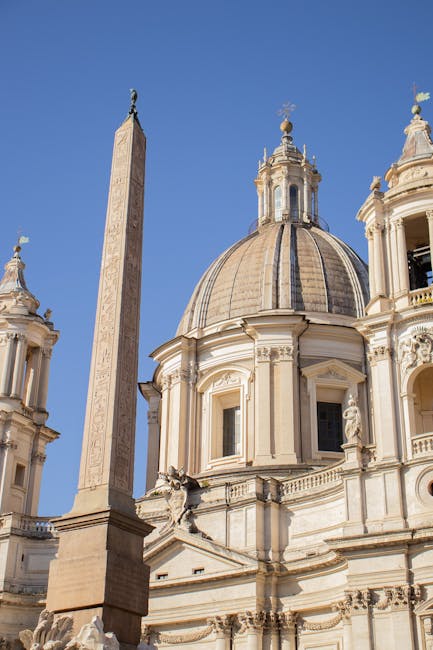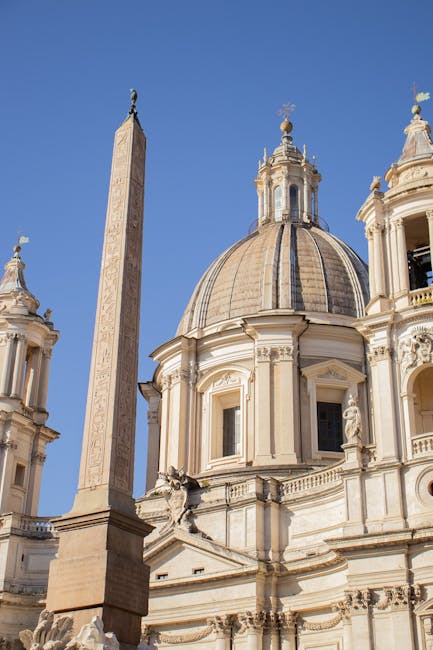Obelisk Definition: Unveiling the History, Symbolism, and Construction of These Iconic Monuments
The word “obelisk” conjures images of towering, four-sided monuments, often capped with a pyramidion. But what exactly defines an obelisk, and what is the rich history and symbolism behind these imposing structures? This comprehensive guide delves into the definition of an obelisk, exploring its origins, construction, symbolism, and notable examples across various cultures and time periods.

Defining the Obelisk
At its core, an obelisk is a tall, four-sided, tapering monument that culminates in a pyramidal or pointed top. Its shape is characterized by a slender, gradually narrowing form, rising from a square or rectangular base. While the exact dimensions vary considerably depending on the specific obelisk, the defining characteristic remains its tall, slender, and pointed form. This distinctive silhouette sets it apart from other monolithic structures such as stelae or pillars.
The term “obelisk” itself derives from the Greek word obeliskos, meaning a “spit” or “broach.” This etymology hints at the monument’s resemblance to a pointed roasting spit, a comparison that highlights its elongated and tapering shape.
Historical Origins and Cultural Significance
The earliest known obelisks emerged in ancient Egypt during the Old Kingdom (c. 2686-2181 BCE). They were not merely decorative elements; they held profound religious and political significance. These ancient Egyptians believed that obelisks represented the sun god Ra’s rays, symbolizing his power and life-giving energy. They were often erected in pairs, flanking the entrances to temples or placed within sacred complexes. Inscriptions and carvings on the obelisks frequently detailed the reign of the pharaoh who commissioned their construction, serving as potent statements of royal power and divine legitimacy.
Egyptian Obelisks: A Symbol of Royal Power
The construction of an Egyptian obelisk was a monumental undertaking, requiring immense skill, manpower, and resources. Massive blocks of granite were quarried, painstakingly shaped, and then transported, often over considerable distances, to their final location. The process involved complex engineering techniques and a deep understanding of material science. The finished obelisk was not only a symbol of royal authority but also a testament to the pharaoh’s ability to command resources and harness the skills of his people.
Beyond Egypt: The Spread of Obelisk Design
The influence of Egyptian obelisks extended far beyond their place of origin. The Romans, fascinated by Egyptian culture, appropriated the obelisk as a symbol of imperial power and grandeur. They transported numerous obelisks from Egypt to Rome, erecting them in public spaces to commemorate victories and enhance the city’s prestige. These relocated monuments became powerful symbols of Roman dominance and cultural appropriation.
Other cultures, albeit less extensively, also incorporated obelisk-like structures into their architecture and symbolism. While not always precisely matching the Egyptian definition, these monuments share similar characteristics, reflecting a universal fascination with tall, slender, and pointed forms.
Construction Techniques and Materials
The creation of an obelisk was a complex and arduous process. The most common material used was granite, chosen for its durability and resistance to weathering. The initial stage involved quarrying the enormous blocks of stone, a task requiring sophisticated techniques and specialized tools. The blocks were then carefully shaped and polished, a process that required immense skill and precision. The final stages involved the transport of the obelisk to its intended location and its erection, often using ingenious methods and elaborate machinery.

Ancient Egyptian Methods
Ancient Egyptians employed a remarkable combination of techniques to construct their obelisks. They utilized copper tools to carve the granite, and levers, rollers, and ramps to move the massive blocks. The precise methods remain a subject of ongoing research, but evidence suggests that a combination of manpower, ingenuity, and sophisticated understanding of leverage played a crucial role.
Roman Adaptations
The Romans adopted and adapted some of the Egyptian techniques, but they also developed their own methods for transporting and erecting obelisks. Their use of cranes and other advanced machinery allowed them to move and position these monuments with greater efficiency.
Symbolism and Interpretation
The symbolism of the obelisk is rich and multifaceted. While its association with the sun god Ra was paramount in ancient Egypt, its meaning evolved and adapted in different cultures and contexts. The towering nature of the obelisk inherently signified power and authority, representing the reach of the gods or the pharaohs. Its pointed apex often symbolized a connection between the earthly and divine realms.

Modern Interpretations
Today, obelisks continue to hold symbolic significance. They are often associated with commemoration, representing historical events, heroes, or ideals. In some contexts, they might be seen as emblems of national pride or monuments of cultural heritage.
Notable Examples
Numerous obelisks stand as testaments to their creators’ skill and ambition. Some of the most famous include:
- Cleopatra’s Needle (London and New York): These obelisks, originally from Egypt, now stand in London and New York City, offering a tangible connection to ancient history.
- The Lateran Obelisk (Rome): This ancient Egyptian obelisk, now situated in Rome, is the tallest ancient Egyptian obelisk standing today.
- The Washington Monument (Washington D.C.): Though not strictly an obelisk in the classical sense, this monument adopts the obelisk’s form and symbolism, serving as a powerful representation of American ideals.
Studying these and other obelisks allows us to understand not only their construction but also the cultural and historical contexts in which they were created and their ongoing significance.
Conclusion
The obelisk, far from being a simple monument, holds a complex and captivating history. Its distinctive shape, rich symbolism, and impressive scale continue to inspire awe and wonder. Understanding the obelisk’s definition, construction, and cultural context provides valuable insights into the ingenuity, beliefs, and power dynamics of various civilizations throughout history.

